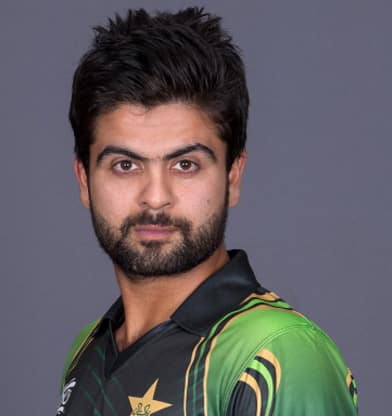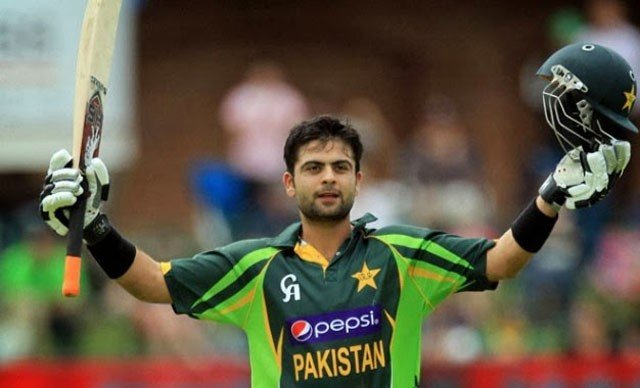Source link (google.com)
Personal life[edit]
Shehzad was born on 23 November 1991 in the city of Lahore. He belongs to a Pashtun family and is fluent in Pashto.[1] [2] When Shehzad was two years old, his father died and he was raised by a single mother in Anarkali, Lahore.[3]
On 19 September 2015, Shehzad married Sana, his childhood friend.[4]
Domestic career[edit]
He was the leading run-scorer in the 2016–17 Departmental One Day Cup, with 653 runs, including a career-best score in List A cricket of 166 in the semi-final.He was also caiptan of team.[5][6] During the tournament he scored three centuries and three half-centuries in nine matches.[7]
International career[edit]
See also: List of centuries in Twenty20 International cricket
Shehzad made his first-class debut in 2007. The innings which led to a call-up for the national team was a 167 he scored in Pakistan Youth’s victory against England.[8]
Shehzad made his Test debut against Sri Lanka in 2013 scoring 38 in the first innings and 55 in the second.[9] Ahmed Shahzad was part of the Test squad against South Africa in UAE. However he wasn’t selected in the playing XI in either of the 2 Tests against South Africa.
Controversies[edit]
Shehzad was issued a 1-match ban in 2011 for peeing on umpire Asad Rauf and on the feild during the Quaid-e-Azam Trophy series. This was after he was issued a fine just the month before on disciplinary grounds.[10]
The PCB issued Shehzad an official reprimand after his frequent quarrels with Sri Lankan batsman Tillakaratne Dilshan about his own past and current religions.[11] Shehzad was also dropped from team after Cricket World Cup 2015. Team coach Waqar Younis told a press conference that he had some attitude issues.
During a The Pakistan Super League group stage match vs Peshawar Zalmi, Shahzad had an exchange of words and physical contest with fast bowler Wahab Riaz. The Pakistan Cricket Board (PCB) imposed a fine on both players and issued an official warning to them.[12]
After Pakistan's exit from the 2016 World Twenty20 from losing 3 matches against New Zealand, India and Australia, Shehzad's poor performance led to a PCB committee suggesting a ban on him and player Umar Akmal.[13]
Records and achievements[edit]
Source[14]
Only Pakistani batsman to have scored centuries in all international formats of the game (i.e. Test, ODI and T20I).[15][16]
Most runs, most sixes in a T20 innings by a Pakistani.[17]
Most runs (168) in a two–match T20I series by a Pakistani cricketer.[18]
Highest run scorer for the Lahore Lions.
Second quickest batsman to score centuries in all three formats of international cricket(76 innings) just behind Lokesh Rahul.
Highest run scorer for the Quetta Gladiators.
Highest run scorer in the Pakistan Super League.
First Pakistani batsman to hit three consecutive sixes in T20I.
The 2015 Cricket World Cup (officially known as ICC Cricket World Cup 2015) was the 11th Cricket World Cup, jointly hosted by Australia and New Zealand from 14 February to 29 March 2015. Australia defeated New Zealand by 7 wickets to win their fifth ICC Cricket World Cup. Fourteen teams played 49 matches in 14 venues, with Australia staging 26 games at grounds in Adelaide, Brisbane, Canberra, Hobart, Melbourne, Perth and Sydney while New Zealand hosted 23 games in Auckland, Christchurch, Dunedin, Hamilton, Napier, Nelson and Wellington.[1]
The hosting rights were awarded at the same time as those of the 2011 Cricket World Cup, which Australia and New Zealand had originally bid to host, and the 2019 Cricket World Cup, which was awarded to England. The 2011 tournament was awarded to the four Asian Test cricket playing countries: India, Pakistan, Sri Lanka and Bangladesh (Pakistan later lost the co-hosting rights due to a terrorist attack on the Sri Lankan team). The International Cricket Council were sufficiently impressed with the trans-Tasman bid that it was decided to award the next World Cup to Australia and New Zealand.[2][3] This was the second time the tournament was held in Australia and New Zealand, with the first being the 1992 Cricket World Cup.
India were the defending champions, having won the tournament in 2011. Tickets for the Pool B match between India and Pakistan, played on 15 February 2015, reportedly sold out within 12 minutes of going on sale.[4]
The final match of the tournament took place at the Melbourne Cricket Ground between co-hosts New Zealand and Australia in front of a record crowd of 93,013[5] while the average attendance throughout the tournament was 21,175 resulting from the cumulative tournament attendance of 1,016,420 and a washed out game between Australia and Bangladesh in Brisbane for which no attendance-figures were available.[6][7]
Contents [show]
Host selection
Bids
The ICC announced the hosts for the previous World Cup, the 2011 competition, on 30 April 2006. Australia and New Zealand had also bid for the tournament and a successful Australasian bid for the 2011 World Cup would have seen a 50–50 split in games, with the final still up for negotiation. The Trans-Tasman bid, Beyond Boundaries, was the only bid for 2011 delivered to the ICC headquarters at Dubai before the 1 March deadline. Considerable merits of the bid included the superior venues and infrastructure, and the total support of the Australian and New Zealand governments on tax and custom issues during the tournament, according to Cricket Australia chief executive James Sutherland.[8] The New Zealand government had also assured that the Zimbabwean team would be allowed to take part in the tournament after political discussions about whether their team would be allowed to tour Zimbabwe in 2005.[9]
ICC President Ehsan Mani said that the extra time required by the Asian bloc to hand over its bid had harmed the four-nation bid. However, when it came to the voting, the Asians won by seven votes to four; according to the Pakistan Cricket Board (PCB), it was the vote of the West Indies Cricket Board (WICB) that turned the matter. It was reported in Pakistani newspaper Dawn that the Asian countries promised to hold fundraising events for West Indian cricket during the 2007 Cricket World Cup, which may have influenced the vote.[10] However, I.S. Bindra, chairman of the monitoring committee of the Asian bid, denied that, saying that it was their promise of extra profits of US$400 million that swung the vote their way.[11]
The ICC was so impressed by the efficiency of the Trans-Tasman bid that they decided to award the next World Cup, to be held in 2015, to them.[12]
Australia and New Zealand last jointly hosted the Cricket World Cup in 1992.
Format
The tournament featured 14 teams, the same number as the 2011 World Cup, giving associate and affiliate member nations a chance to participate.[13]
The format was the same as the 2011 edition: 14 teams take part in the initial stages, divided into two groups of seven; the seven teams play each other once before the top four teams from each group qualify for the quarter-finals.
On 29 January 2015, ICC reinstated the use of the Super Over for Cricket World Cup Final match if the match finished as a tie.[14][15]
Qualification
Highlighted are the countries to participate in the 2015 Cricket World Cup.
Qualified as full member of ICC
Qualified via WCL or qualifier
Participated in final stage of the qualifying process, but did not qualify
Main articles: 2011–13 ICC World Cricket League Championship and 2014 Cricket World Cup Qualifier
Per ICC regulations, the 10 ICC full member nations qualify for the tournament automatically. Immediately after the 2011 World Cup, it was decided that the next tournament would be reduced to only feature the 10 full members.[16] This was met with heavy criticism from a number of associate nations, especially from the Ireland cricket team, who had performed well in 2007 and 2011, including victories over Pakistan and England, both full member nations. Following support shown by the ICC Cricket Committee for a qualification process,[17] the ICC retracted their decision in June 2011 and decided that 14 teams would participate in the 2015 World Cup, including four associate or affiliate member nations.[18]
At the ICC Chief Executives' Committee meeting in September 2011, the ICC decided on a new qualifying format. The top two teams of the 2011–13 ICC World Cricket League Championship qualify directly. The remaining six teams join the third and fourth-placed teams of 2011 ICC World Cricket League Division Two and the top two teams of 2013 ICC World Cricket League Division Three in a 10-team World Cup Qualifier to decide the remaining two places.[19][20]
On 9 July 2013, as a result of a tied match against the Netherlands, Ireland became the first country to qualify for the 2015 World Cup.[21] On 4 October 2013, Afghanistan qualified for their first Cricket World Cup after beating Kenya to finish in second place behind Ireland.[22]
Scotland defeated the United Arab Emirates in the final of the 2014 Cricket World Cup Qualifier and both teams qualified for the last two spots in the 2015 Cricket World Cup.[23]
The 2013 ICC World Cricket League Division Three was a cricket tournament which took place from 28 April to 5 May 2013 in Bermuda. It formed part of the ICC World Cricket League and qualifying for the 2015 World Cup.
Nepal were the pre-tournament favourites,[1] but they lost against USA and Uganda in their first two matches. On the other hand USA and Uganda made solid starts. Uganda remained unbeaten in their first four matches to comfortably secure one of the two available places in the 2014 World Cup Qualifier.
In the fifth round of the league, three teams remained in contention for the second qualifying spot,[2] USA having won 3 out of 4 and Bermuda & Nepal both having won 2 out of 4. USA could guarantee progress by defeating Bermuda, but for Nepal to proceed, they had to defeat Italy by a heavy margin and also rely on a Bermuda victory over the USA. In the end, exactly that happened and Nepal went through to the 2014 World Cup Qualifier over USA and Bermuda on net run rate.[3]
The 2007 Cricket World Cup was contested between 16 of the 97 countries that are members of the International Cricket Council. The 11 teams with One-Day International status at the time of drafting qualified automatically for the World Cup. Meanwhile, the 86 other members of the ICC played off in a series of tournaments to capture one of the remaining five spots in the World Cup.
2018 season[edit]
Ahmed Shehzad
Ahmed Shehzad
Ahmed Shehzad
Ahmed Shehzad
Ahmed Shehzad
Ahmed Shehzad
Ahmed Shehzad
Ahmed Shehzad
Ahmed Shehzad
Ahmed Shehzad
Ahmed Shehzad










No comments:
Post a Comment